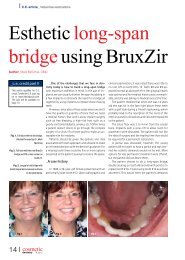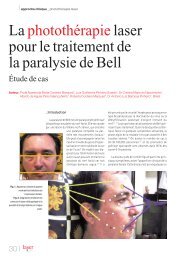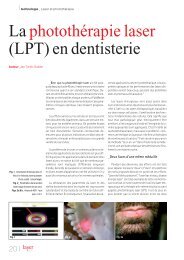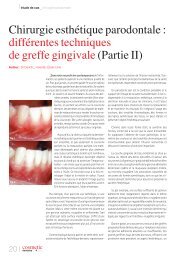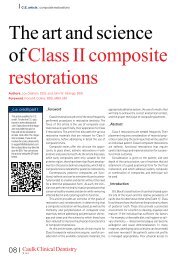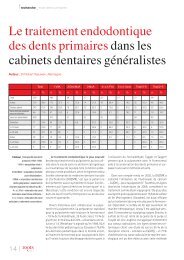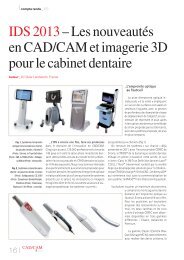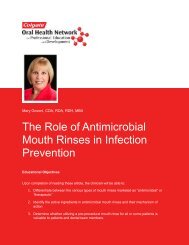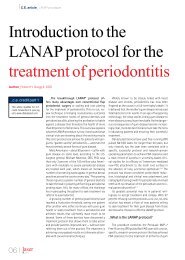Periodontal Disease and Overall Health: A Clinician's Guide
Periodontal Disease and Overall Health: A Clinician's Guide
Periodontal Disease and Overall Health: A Clinician's Guide
Create successful ePaper yourself
Turn your PDF publications into a flip-book with our unique Google optimized e-Paper software.
6 <strong>Periodontal</strong> <strong>Disease</strong> <strong>and</strong> <strong>Overall</strong> <strong>Health</strong>: A <strong>Clinician's</strong> <strong>Guide</strong>Table 1. <strong>Periodontal</strong> <strong>Disease</strong>sVIII. Gingival <strong>Disease</strong>sDental plaque-induced gingival diseasesNonplaque-induced gingival lesionsIV.II. Chronic PeriodontitisLocalizedGeneralizedVIII. Aggressive PeriodontitisLocalizedGeneralizedIIIV. Periodontitis as a Manifestation ofIV. Systemic <strong>Disease</strong>sIIIV. Necrotizing <strong>Periodontal</strong> <strong>Disease</strong>sNecrotizing ulcerative gingivitisNecrotizing ulcerative periodontitisIIVI. Abscesses of the PeriodontiumGingival abscessPeriodonal abscessPericoronal abscessIVII. Periodontitis Associated withEndodontic LesionsVIII. Developmental or Acquired Deformities<strong>and</strong> ConditionsAdapted from: Ann Periodontol 1999;4:1–6. 3previously developed by the AAP. 4,5 Thecurrent case types for periodontal diseasesinclude:• Gingivitis (Case Type I)• Mild periodontitis (Case Type II)• Moderate periodontitis (Case Type III)• Advanced periodontitis (Case Type IV)• Refractory periodontitis (Case Type V)Gingival <strong>Disease</strong>sGingival disease is further characterizedinto plaque-induced <strong>and</strong> nonplaque-inducedcategories. 3Plaque-Induced Gingival <strong>Disease</strong>sGingivitis is gingival inflammation associated with plaque <strong>and</strong> calculus accumulation.It is the most common form of gin -gival disease. Gingivitis may or may notprogress to periodontitis, in which clinicalattachment <strong>and</strong> alveolar bone loss willdevelop. Gingivitis can occur on teeth withno attachment loss; it also occurs in the gingivaof teeth previously treated for periodontitiswith no further attachment loss.Dental Plaque Only: Gingivitis is initiatedby local accumulation of bacteria (i.e.,dental plaque) adjacent to the tooth. 6 Thebacterial antigens <strong>and</strong> their metabolic products(e.g., endotoxin) stimulate epithelial <strong>and</strong>connective tissue cells to produce inflammatorymediators that result in a localizedinflammatory response recruiting polymorphonuclearleukocytes (PMNLs or neutro -phils) to the site. An antibody response tothese bacterial antigens is also mounted. Inflammatorycells <strong>and</strong> their products (e.g.,cytokines, enzymes, <strong>and</strong> antigens) are presentat the site of inflammation. Thus, a hostimmuno-inflammatory response is establishedin the gingival tissues <strong>and</strong> the clinicalsigns of gingivitis develop, including redness,swelling, <strong>and</strong> bleeding. The plaquehostinteraction can be altered by the effectsof local factors, systemic factors, or both.Systemic Factors: Systemic hormonalchanges associated with puberty, menstrualcycle, or pregnancy, as well as with chronicdiseases such as diabetes, can alter the hostresponse to dental plaque. 1,7 Hormonalchanges <strong>and</strong> certain diseases can upregulatesystemic cellular <strong>and</strong> immunologic functionresulting in local severe gingival inflammation,even in the presence of minimal plaqueor with an equivalent bacterial bioburden toa person who does not have these systemicchallenges. This is commonly seen in pregnantwomen who have not had adequate oralhygiene before becoming pregnant. Blooddyscrasias such as leukemia may also alterimmune function by decreasing normal immunologicalfunction. Patients usually presentwith gingival enlargement <strong>and</strong> bleedingassociated with spongy gingival tissues <strong>and</strong>excessive vascularity.Medications: Medications such as anticonvulsantdrugs (e.g., dilantin), immuno-



